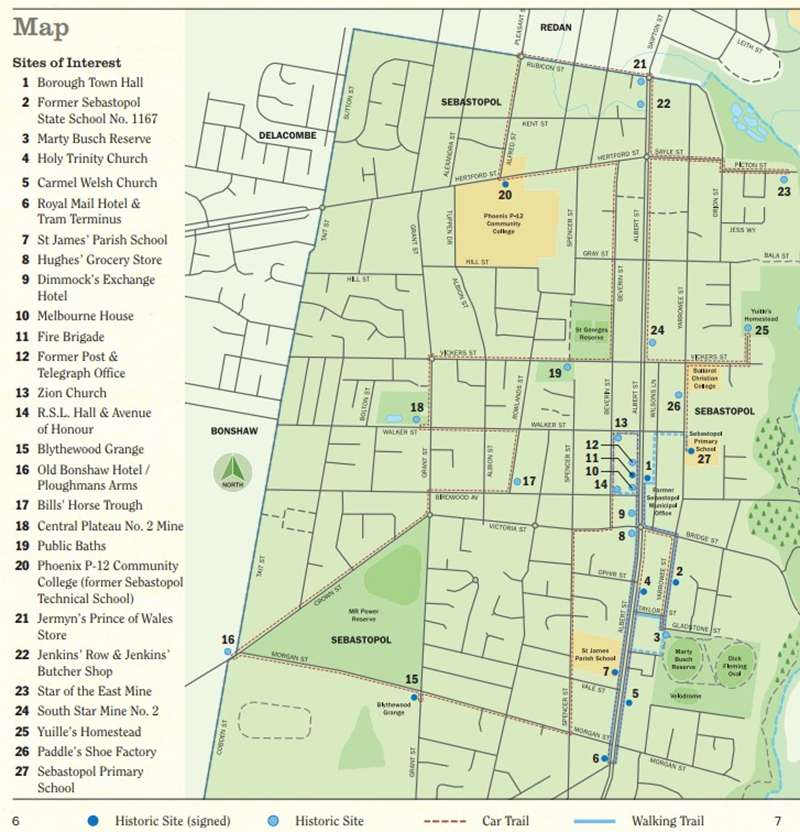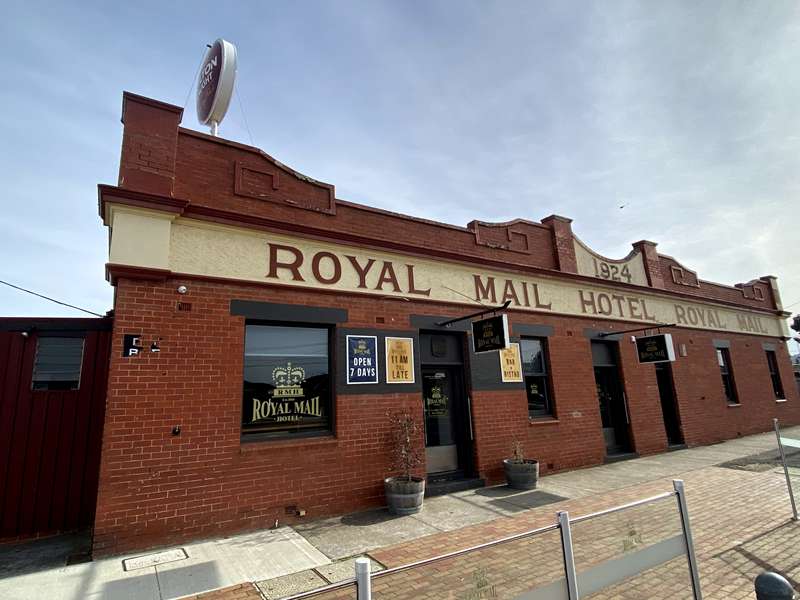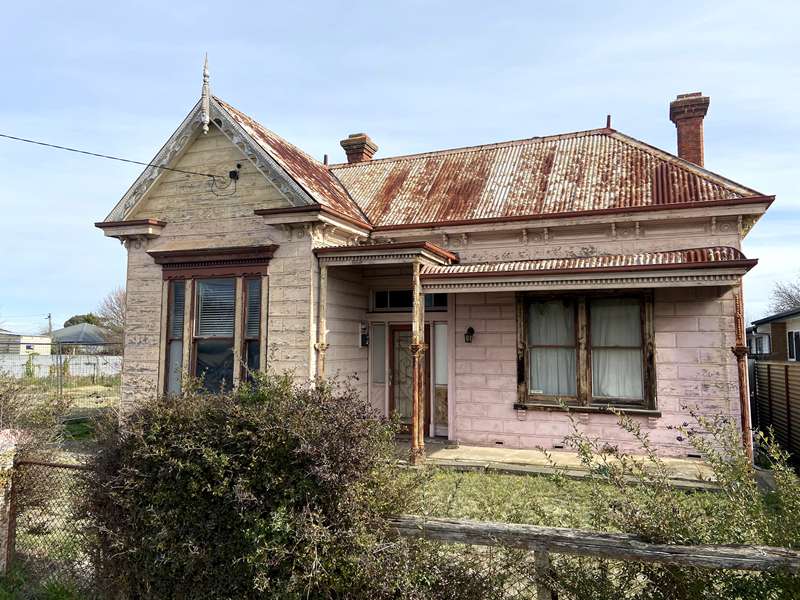Ballarat - Discover Historic Sebastopol

Did you know that the Sebastopol Fire Station was originally built on the opposite side of Albert Street (near the current library) and the building was physically moved across to its current location across the road in 1929? Or that the Central Plateau mines in Sebastopol yielded 34,789 ounces of gold; today worth approximately 85 million dollars? Or that an elephant once escaped a circus and spent several hours roaming the streets of Sebastopol? Explore these forgotten stories and sites of Sebastopol on the Discover Historic Sebastopol trail.
Ballarat Neighbourhood Centre and the Sebastopol Historical Society have produced a series of signs and a complementary information brochure, marking significant historical sites across Sebastopol. Places of interest were identified and at ten significant sites there are information signs.
Sites include Sebastopol Town Hall, the former Sebastopol State School, Holy Trinity and Carmel Welsh Churches, Blythewood Grange, the Fire Brigade and others including the Tram Terminus at the Royal Mail Hotel in Albert Street. The Discover Historic Sebastopol brochure covers 27 historical sites with a map, stories and rare photos of each site.
Either download the Discover Historic Sebastopol brochure or collect a copy of the brochure from various places around Sebastopol, including:
- Ballarat Neighbourhood Centre, 11 Tuppen Drive Sebastopol
- Sebastopol Historical Society (brochure holder on the Former Sebastopol State School sign out the front of 185 Yarrowee Street)
- Sebastopol Library, 181 Albert Street, Sebastopol
Discover Historic Sebastopol Map

Sites of Interest
1 Borough Town Hall
2 Former Sebastopol State School No. 1167
3 Marty Busch Reserve
4 Holy Trinity Church
5 Carmel Welsh Church
6 Royal Mail Hotel & Tram Terminus

Royal Mail Hotel
The Royal Mail Hotel has stood on the corner of Albert and Queen Streets since 1865, when it was established by Licensee James Leonard. This original simple wooden building burnt down within twelve months and the licence transferred to T. Pengilly, who ran the hotel until 1874. In the 1860s, at the peak of the goldrush, Albert Street (then Government Road), was the only all-weather road to the Port of Geelong. It would have been busy with arriving diggers and wool teams from surrounding properties heading to Geelong.
In 1886, its first female licensee, Caroline Ingle, took over. She transferred the licence to her husband Frederick Ingle in 1888. Ingle was the Mayor of Sebastopol at the time and used his position as Hotelier and Mayor to lobby for the tram line to be extended past Morgan Street to the front of his premises. It remained the tram terminus until the tram network closed in 1971.
In 1915 in an effort to reduce the number of hotels in the Ballarat area, the hotel was targeted by the Licences Reduction Board. Luckily for Sebastopol, the hotel successfully appealed at its hearing and was able to remain trading.
In 1923 the hotel came into the ownership of the Ballarat Brewing Company, who in 1924 replaced the run-down weather-board building with the current brick structure. It remained in their ownership until 1939. Since then, the hotel has had many owners, one being the Sebastopol Football Club, who took over the freehold of the hotel in 1997 and ran it for some years.
Sebastopol Tram Terminus
In April 1888. the Ballaarat Tramway Company opened a horse-drawn tram service from Sturt St terminating at the municipal boundary at Rubicon St Negotiations between the Ballaarat Tramway Company and Sebastopol Council to extend the line into Sebastopol commenced in July 1891. The public voted in favour of the extension and in March 1893 the horse-drawn tram line was extended as far as the Sebastopol Town Hall. Ultimately, the tram terminus outside the Royal Mail Hotel was reached in April the same year.
In 1905 the conversion to electric trams commenced in Ballarat and by March 1908, the electric trams ran south from Shirt St along Skipton St as far as Rubicon St, via a new route along Drummond St South. Passengers travelling further on to Sebastopol had to change to a horse-drawn tram. On the 14th April 1913, Ballarat's last horse-drawn tram line, the Sebastopol line, was converted to electric trams, offering residents of Sebastopol a direct service into Ballarat for the first time.
In the early 1900s the Electric Supply Company of Victoria operated the tram service. During the 1930s the State Electricity Commission (SEC) gradually took over control of the tram lines. In August 1937, a re-routing of the entire network took place. Rather than all trams terminating in the city area, they were 'through routed' to travel to other outer areas. Thus, the Sebastopol to Lydiard St North tram route was formed and was the longest tram route in Ballarat with a total distance of 5.3 miles.
During 1971, the SEC commenced the closure of Ballarat's tramway network over a six-week period. The Lydiard St North to Sebastopol tram line became the last tram route in Ballarat and at 11:02 p.m. on Sunday 19th September 1971, a crowd of over 5,000 people gathered outside the Royal Mail Hotel to farewell the final tram operating in Ballarat. (Visit Sign 6 in Albert Street for more details.)
7 St James' Parish School
8 Hughes' Grocery Store
9 Dimmock's Exchange Hotel
10 Melbourne House
11 Fire Brigade
12 Former Post & Telegraph Office
13 Zion Church
14 R.S.L. Hall & Avenue of Honour
15 Blythewood Grange
16 Old Bonshaw Hotel / Ploughmans Arms
17 Bills' Horse Trough
18 Central Plateau No. 2 Mine
19 Public Baths
20 Phoenix P-12 Community College (former Sebastopol Technical School)
21 Jermyn's Prince of Wales Store
22 Jenkins' Row & Jenkins' Butcher Shop
23 Star of the East Mine
24 South Star Mine No. 2

The South Star Mine was the deepest on the Ballarat Goldfield with its shaft bottoming at 3,170 feet and producing 64,444 ozs of gold. It was Ballarat's 12th richest quartz mine. The South Star Company was established in September 1886 and a shaft sunk. At the 200ft level old mine workings were broken, the shaft flooded rapidly and could not be contained. A second shaft, the South Star No. 2, was sunk. 180 men worked a roster of three shifts a day. The mine only stop-ping its machinery for the Sabbath. Initially crushing of gold bearing quartz was done at the Star of the East Mine, until a 60 Head Battery was installed at the South Star. 133,000 tons of quartz were crushed at the battery.
In 1901, on a visit to Ballarat after opening Australia's first federal parliament, the Duke of York (later King George V) visited the mine, descending the shaft in a cage to visit the workings. It is reputed that he changed out of his suit at the Mine Manager's house. The company operated three shafts. In its final months the company grew obsessed with deepening the main shaft, when this time could have been spent exploring unmined ground in the upper levels, and as a result heavy debt was attracted. In 1909, due to the constant expense of pumping water and large debts, the mine closed. The shafts quickly flooded and became unworkable. All that remains of the mine today is the weatherboard mine office building and the Manager's house facing each other at 121 and 122 Albert Street.
25 Yuille's Homestead
26 Paddle's Shoe Factory
27 Sebastopol Primary School
Web Links
→ Discover Historic Sebastopol Website








